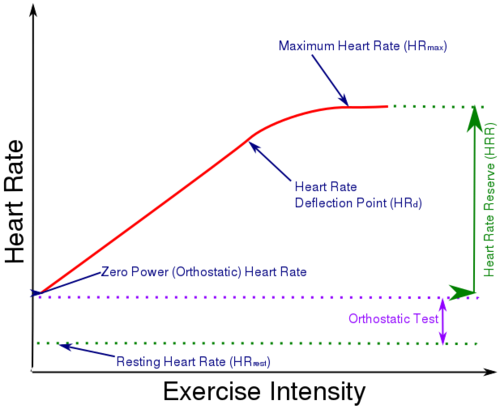Heart Rate Reserve (HRR)

Heart Rate Reserve is a how much your Heart Rate can speed up with exercise. It's the difference between the fastest heart rate (Maximum Heart Rate) and the slowest (Resting Heart Rate.)
Contents
1 Calculating Percent Heart Rate Reserve
Heart Rate Reserve (HRR) is normally calculated as the difference between your Maximum Heart Rate (HRmax) and Resting Heart Rate (HRrest). Exercise intensity can be evaluated by calculating your heart rate as a percentage of HRR. The calculation to work out %HRR is…
%HRR = (HRex – HRrest)/(HRmax – HRrest)
Where HRex is the exercise Heart Rate. For example, for a HRmax of 180, a HRrest of 40 and HRex of 140 would be (140 – 40)/(180 – 40), which is 71%.
2 Why use Percentage Heart Rate Reserve?
Using %HRR is better than a percentage of HRmax, as it reflects the relative intensity more accurately. For example, if two athletes both have a HRmax of 180, but one has a HRrest of 40 and the other 70, at a HR of 140 they would both have the same %HRmax, but one is at 64 %HRR and the other is at 71 %HRR.
3 Issues with Percentage Heart Rate Reserve
While HRR is a good way of looking at effort and intensity, but there are two issues to be aware of.
- For HRR to be of value, you have to test your HRmax, as it cannot be calculated. Calculating HRmax is a mistake that can lead to misleading views of effort.
- I believe we should use the Orthostatic Heart Rate (HRorth)which is the Heart Rate when standing rather than HRrest, as HRorth is typically 10-15 beats higher than HRrest, which is enough to skew the relative effort percentage.
Most Heart Rate Monitors will display your %HRR if you input your HRmax and HRrest.
4 %HRR, %V̇O2max, and V̇O2max Reserve
Just as %HRR is the percentage of the difference between resting and max heart rate, so V̇O2max Reserve is the difference between resting V̇O2 and V̇O2max. If you need to convert %HRR to %V̇O2max, there's some correlation (r=0.78[1]), and you can use this formula to get a rough estimate[2]:
%V̇O2max = %HRR x 1.12 – 12
So, if you're at 60% of HRR, that's (60 x 1.12) – 12 = 55% V̇O2max.
5 See Also
6 References
- ↑ TJ. Solheim, BG. Keller, CJ. Fountaine, VO, Int J Exerc Sci, volume 7, issue 4, pages 311-317, PMID 27182409
- ↑ David P. Swain, Brian C. Leutholtz, Heart rate reserve is equivalent to%??VO2Reserve, not to%??VO2max, Medicine & Science in Sports & Exercise, volume 29, issue 3, 1997, pages 410–414, ISSN 0195-9131, doi 10.1097/00005768-199703000-00018